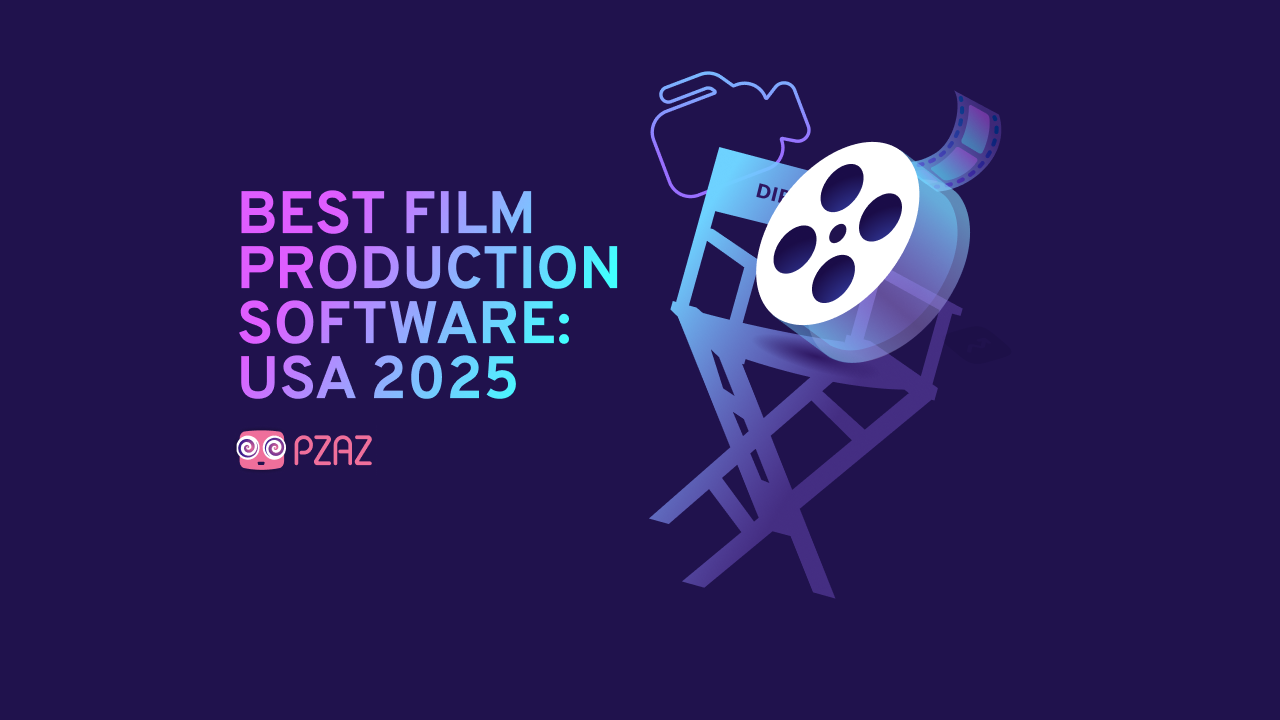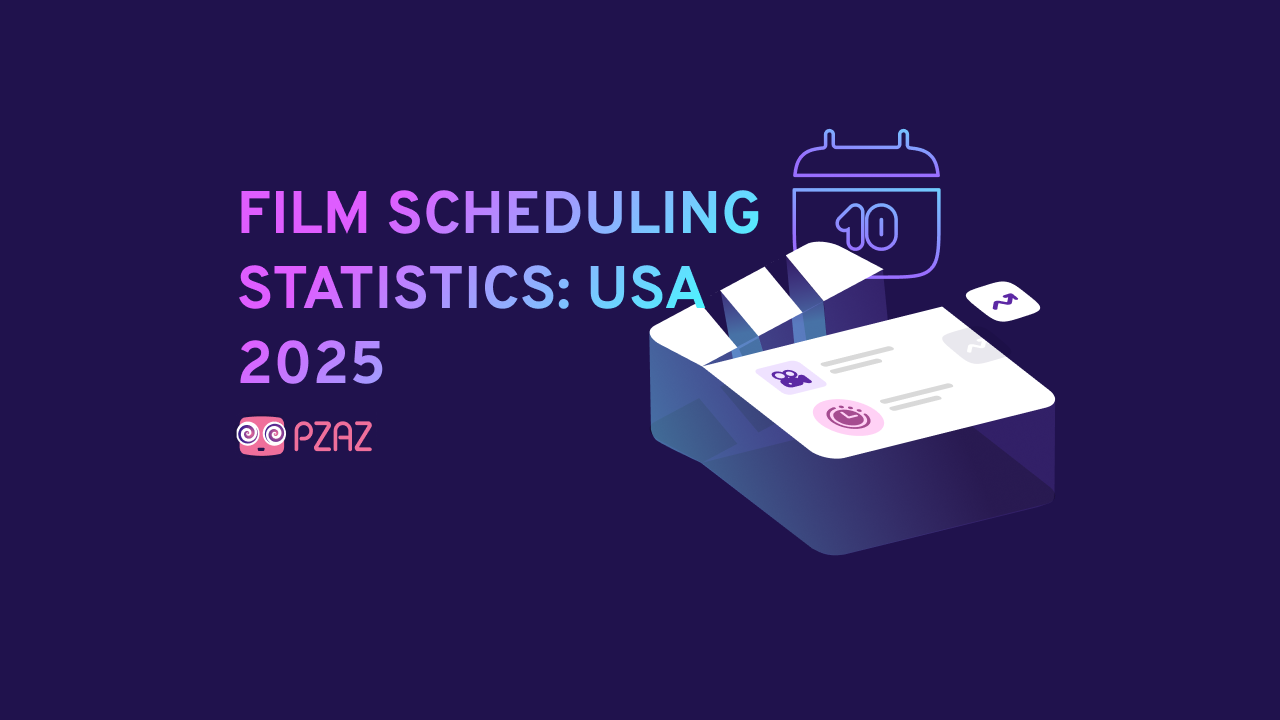
Behind every great film is a rock-solid schedule—or at least an attempt at one. For independent filmmakers across the US, planning shoot days, managing crews, and juggling last-minute changes are all part of the production rollercoaster. But how are they handling it in 2025?
To find out, we surveyed data from 16,608 indie filmmakers that was compiled using AI-driven audience profiling to synthesize insights from online opinions to a high statistical confidence level. The data spanned a full year, ending April 14, 2025, and revealed the real story behind scheduling in the independent film industry.
Index
-
- 100% of independent filmmakers in the US rely on assistants to manage production schedules
- 83% independent filmmakers cite last-minute changes as the biggest hurdle for production schedule management
- Poor scheduling affects budgets and delays production timelines for 93% of independent filmmakers
- 68% filmmakers agree 1st AD or production managers are in charge when schedules conflict
- 100% of independent filmmakers have used dedicated film scheduling tools
- 100% of independent filmmakers would use a tool that would halve scheduling time
- 64% filmmakers want a scheduling tool that prioritizes ease of use
- Despite 100% of filmmakers being confident of a realistic schedule, delays still arise
- For 38% of filmmakers, scheduling doesn’t hinder creative exploration
- 56% of filmmakers say shoot days stay on schedule half the time
- Messaging apps used to share final schedules by 52% filmmakers
- Documentaries the most common project for 47% independent US filmmakers
- 67% independent filmmakers in the US are based in the Midwest
- Methodology
How Do You Currently Prefer To Manage Your Production Schedule?
100% of independent filmmakers in the US rely on assistants to manage production schedules
It’s unanimous—assistants are the only choice for managing production schedules:
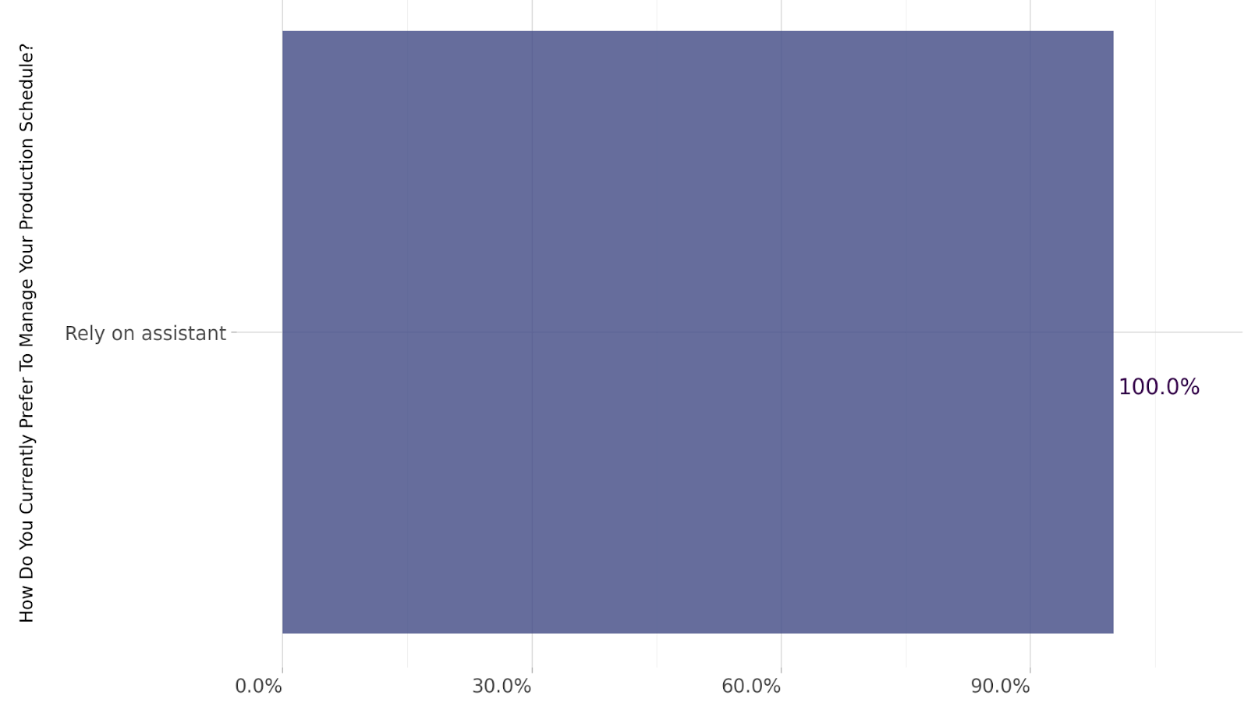
Every one of our audience of 16,608 independent filmmakers in the US relies on assistants to manage their production schedules. This is a major responsibility, and Zippia rates the job’s complexity as “challenging”. However, stress levels are rated as “manageable,” indicating that while assistants are the preferred production schedule managers, they don’t find the task too hard to handle.
What Is Your Biggest Challenge When Managing Production Schedules?
83% independent filmmakers cite last minute changes as the biggest hurdle for production schedule management
It’s clear that one challenge leads the way as the most problematic:
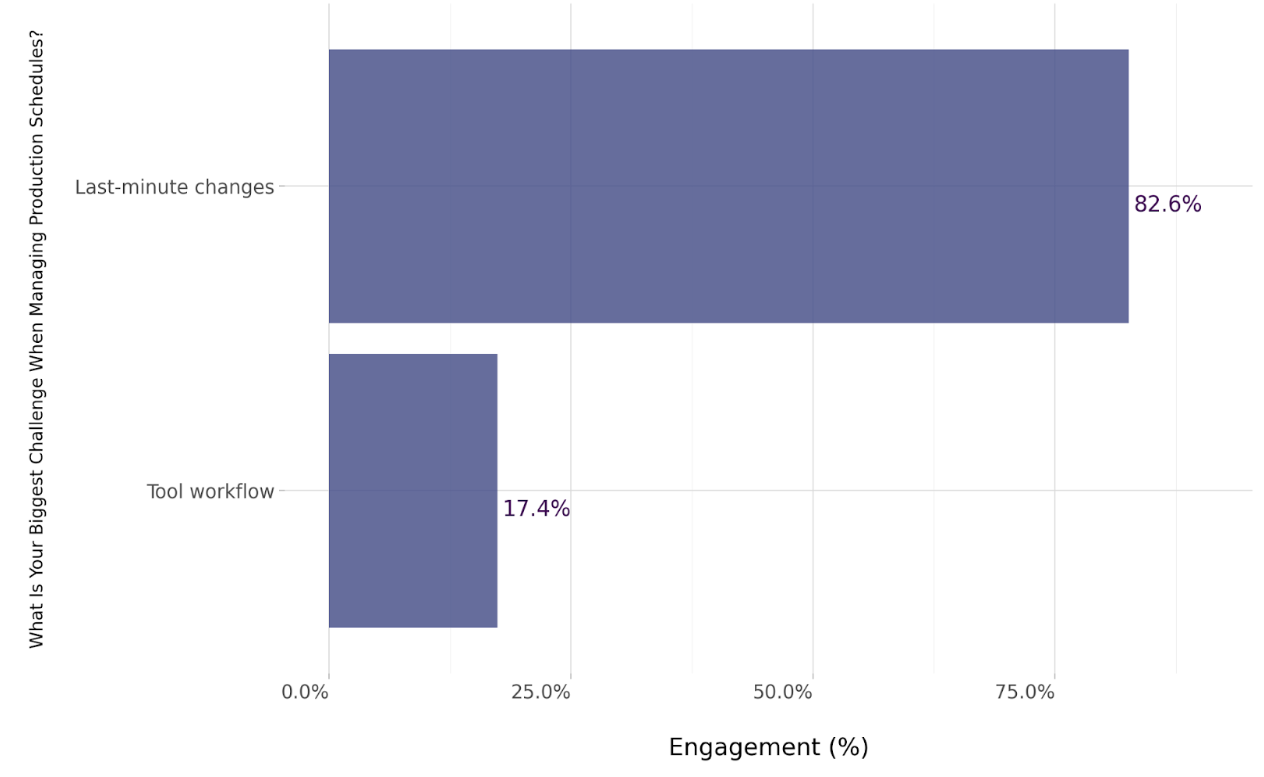
With 83% of independent filmmakers citing last-minute changes as the biggest challenge when managing a production schedule, there’s no doubt that unexpected events or incidents have a major impact on the making of a movie. In contrast, 17% say that tool workflow is the biggest hurdle. This is interesting as it highlights a greater need for the adoption of technology or software that can streamline scheduling processes.
How Often Does Poor Scheduling Affect Your Budget Or Delay Your Production Timeline?
Poor scheduling affects budgets and delays production timelines for 93% of independent filmmakers
With often costly ramifications, poor scheduling is clearly a major issue for filmmakers:
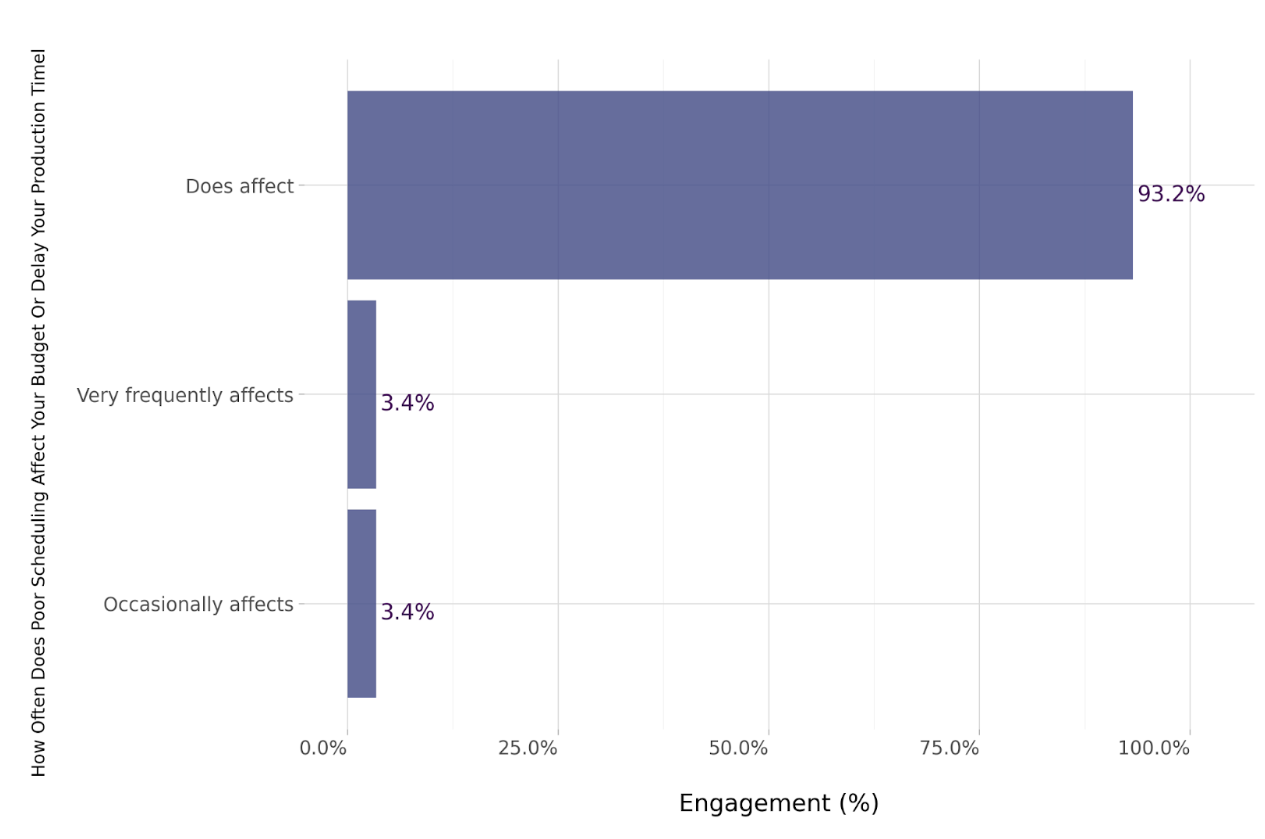
Considering that the average cost of a short film is between $700 and $1,500 (or more) a minute, it’s understandable that 93% of our audience says that poor scheduling does impact their budget and delays production time. Fortunately, only 3% say that this is a very frequent occurrence, while the same percentage says it only affects them occasionally.
Who Has The Final Say When A Scheduling Conflict Arises?
68% filmmakers agree 1st AD or production managers are in charge when schedules conflict
Someone has to make a call on what happens when scheduling conflicts occur:
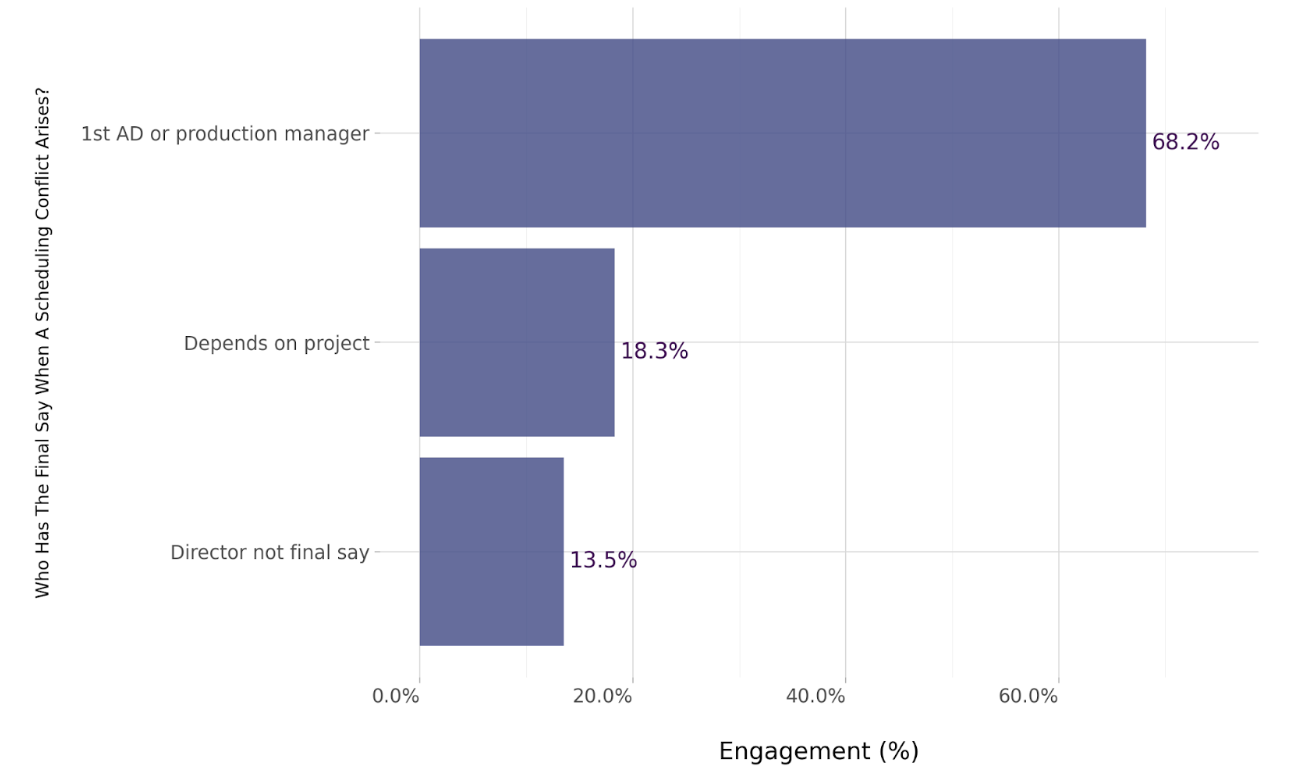
When scheduling conflicts arise, the buck stops with the first assistant director or production manager for 68% of independent filmmakers. This is likely because indie film crews are smaller and have fewer resources, so the responsibilities typically fall to those closest to day-to-day operations. They’re the ones coordinating cast, crew, and locations, so conflicts naturally land on their plate.
18% of filmmakers say that the final say will depend on the project, while 14% say it won’t be the director. This suggests that decision-making authority in film scheduling can be flexible, with some filmmakers adjusting leadership based on the project’s needs, and others indicating that directors aren’t always in charge, highlighting a more collaborative or producer-led approach in certain cases.
Have You Ever Used A Dedicated Film Scheduling Tool?
100% of independent filmmakers have used dedicated film scheduling tools
It’s evident that indie filmmakers recognize the value of film scheduling tools:
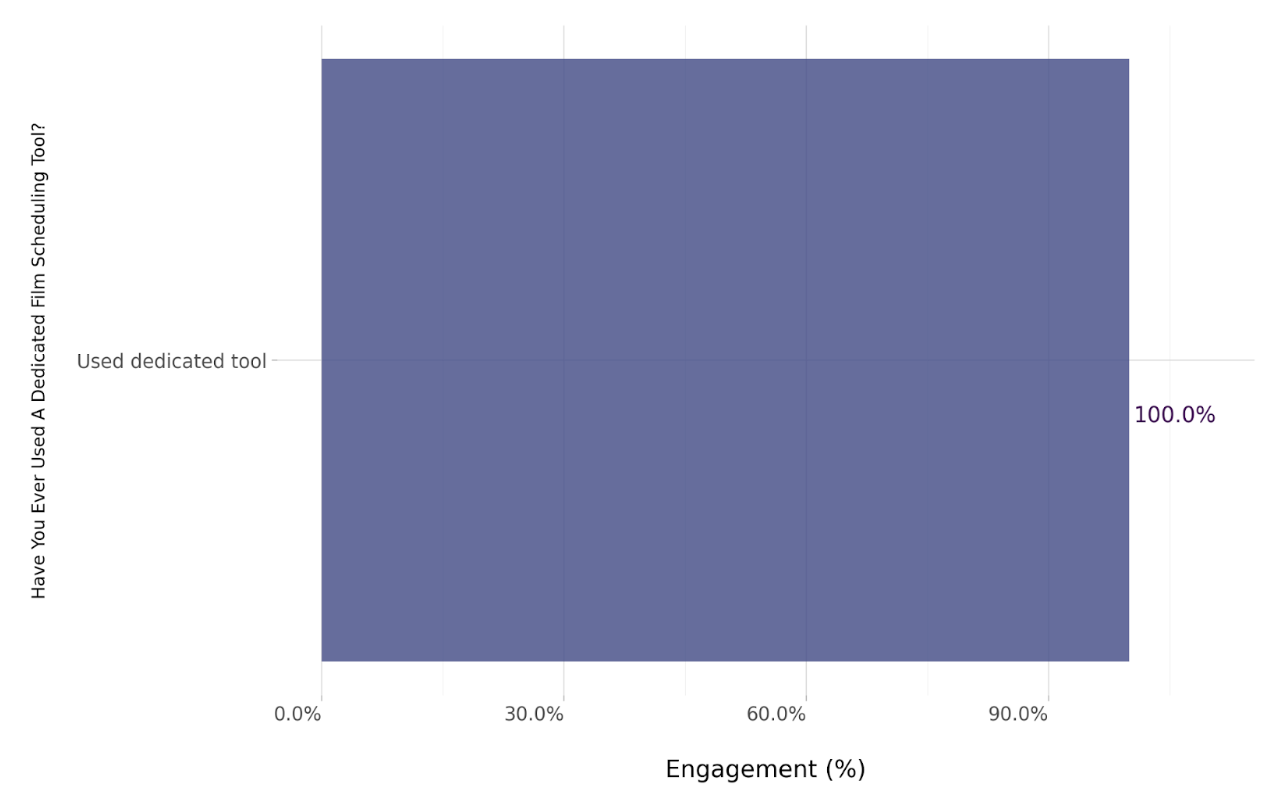
Once again, our audience agrees unanimously on something. However, it’s interesting to note that previously, 17% said that tool workflow is the biggest challenge when managing production schedules. This reinforces the fact that a dedicated production scheduling tool that also integrates with other aspects of filmmaking is essential, as it plays such an integral role in the process.
Would You Use A Tool That Could Cut Your Scheduling Time In Half?
100% of independent filmmakers would use a tool that would halve scheduling time
Again, all of our audience agrees they’d use a tool to slash scheduling time:
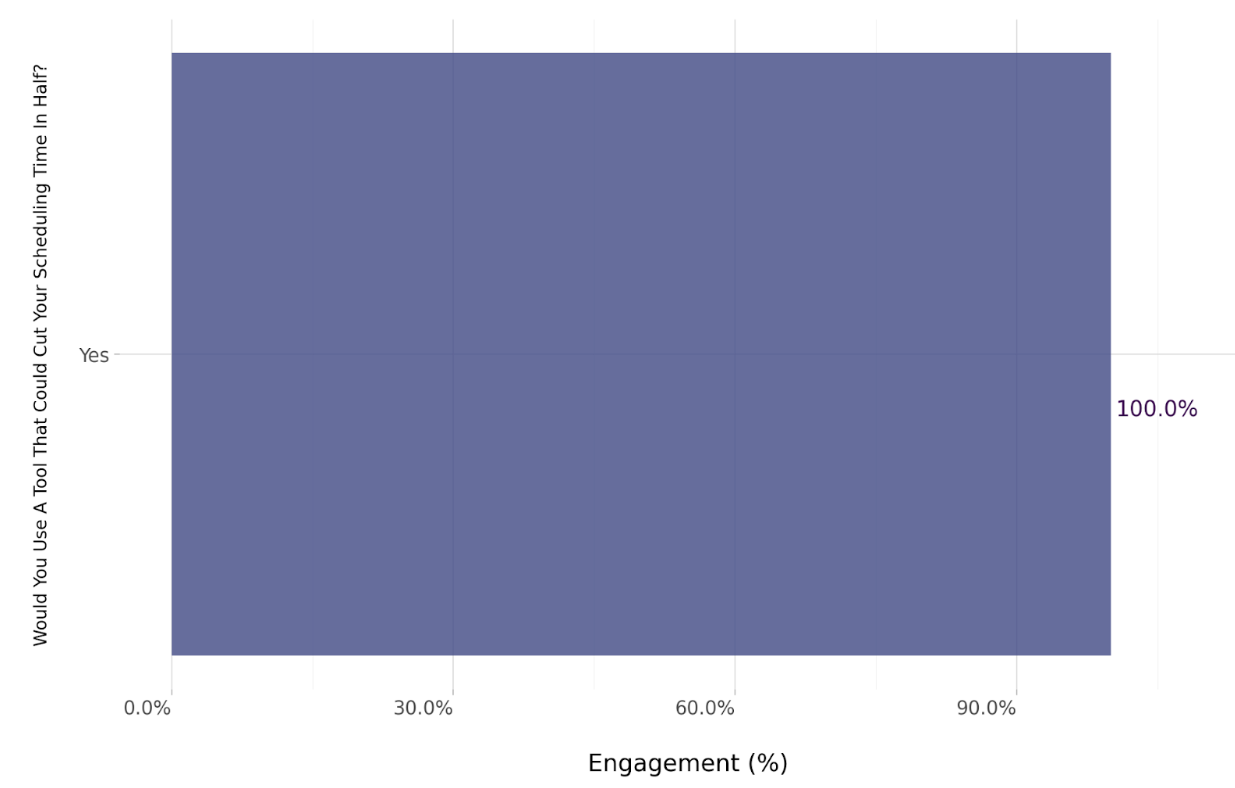
In 2023, the top ten independent films at the box office brought in a combined $1.6 billion. Now, imagine if filmmakers could make even more movies by slashing scheduling time in half? It’s no wonder that 100% say that they’d use a tool that would do this. Not only would it increase efficiency, streamline the entire shooting process, and mitigate scheduling-related budgeting issues, but it would also create the opportunity for more indie films to be made in less time.
What Do You Look For In A Scheduling Solution?
64% filmmakers want a scheduling tool that prioritizes ease of use
Three main requirements stand out for filmmakers when looking at scheduling tools:
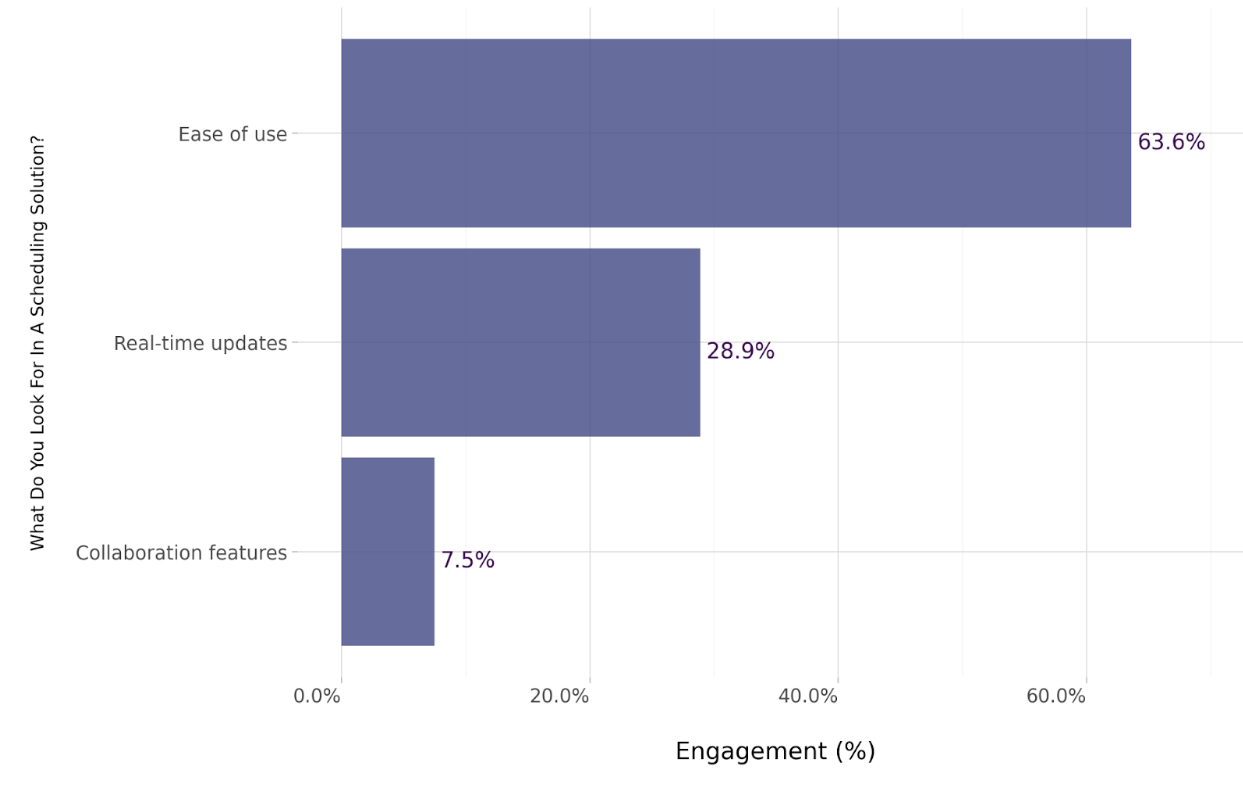
With the value of the on-call scheduling software market expected to reach $12.6 billion by 2030, there’s a definite demand for scheduling solutions not just in filmmaking but across all businesses. For our audience, there are three predominant attributes they look for when choosing what solution to use.
The most sought-after is ease of use, with 64% citing this as their main requirement. This is followed by 29% with real-time updates and 8% with collaboration features. Due to the nature of filmmaking, where teams are often mobile, timelines shift rapidly, and coordination is critical, these attributes become essential for keeping productions on track and minimizing costly delays.
How Confident Are You That Your Schedule Reflects Real Time Availability Across Your Team And Locations?
Despite 100% of filmmakers being confident of a realistic schedule, delays still arise
In filmmaking, there’s no avoiding delays:

Yet another unanimous response from our 16,608 USA independent filmmakers shows that delays still happen even when they’re confident about having a realistic timeline for filming, including when and where each scene will be filmed, actor availability, location access, budget constraints, and crew schedules.
This is evident in the many movies that have suffered from long delays, with “The Other Side of the Wind” being a prime example. It took a whopping 48 years to make this film, and the irony was that the storyline centered on a legendary director who struggles to complete a new project and contemplates his legacy in the last 24 hours of his life.
How Do You Feel Scheduling Impacts Your Creative Flow During Production?
For 38% of filmmakers, scheduling doesn’t hinder creative exploration
Timing issues and holdups have varying effects on filmmakers:
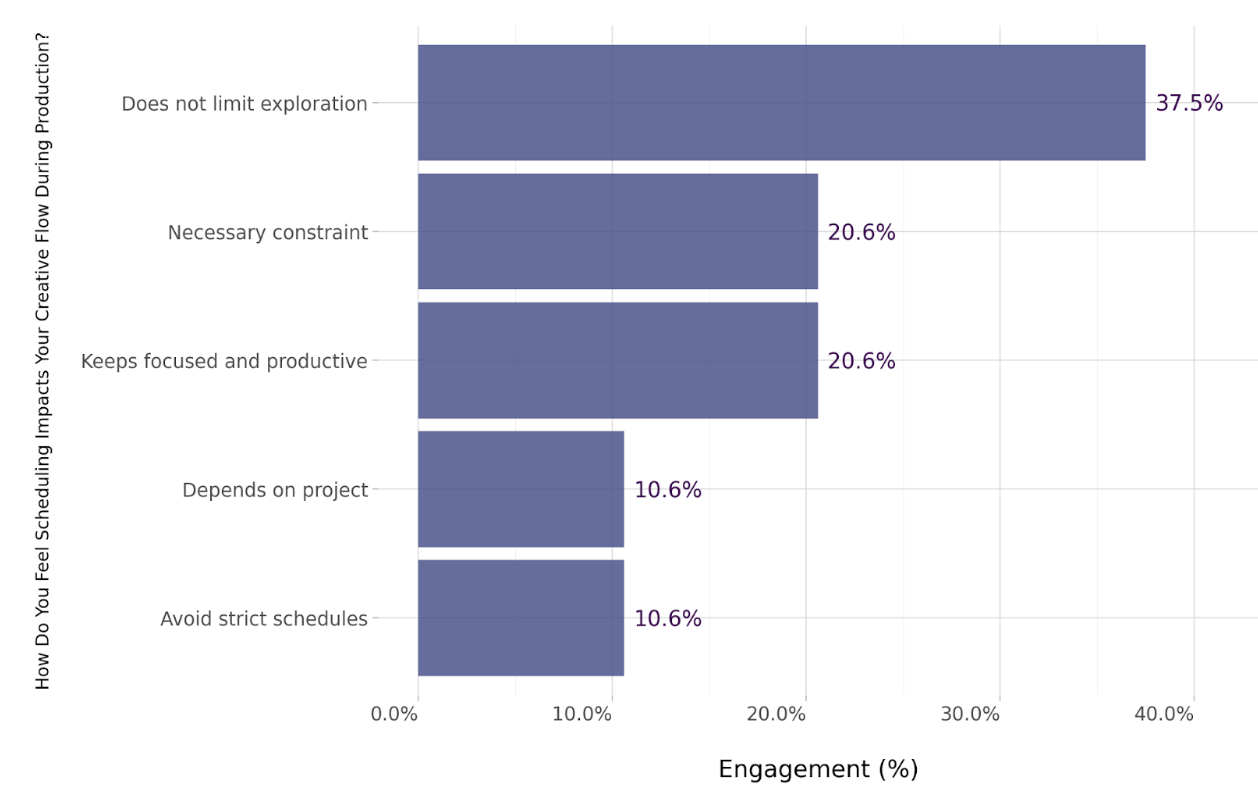
It’s a well-known fact that independent filmmakers have far more freedom to express their ideas, and Hollywood doesn’t stifle their creativity. But this doesn’t mean they don’t have other factors influencing their creative flow when filming, and scheduling can have an impact. Fortunately, for 38%, scheduling doesn’t limit their exploration, and 20% say it’s a necessary constraint. Another 20% say it keeps them focused and productive, while 11% say it depends on the project. The other 11% avoid strict schedules to ensure their creative flow isn’t impacted.
How Often Do Your Shoot Days Stay Fully On Schedule As Originally Planned?
56% of filmmakers say shoot days stay on schedule half the time
Keeping shoot days on schedule is a challenge, but it’s one that can be met:

For 56% of our audience, keeping shoot days fully on schedule is something that happens half the time. Whether due to timing, weather, availability, cast or crew issues, or other issues, deviations from schedules in filmmaking are very common. For this reason, it’s interesting to note that 36% stay fully on schedule most of the time and 8% do so almost always. This is impressive during a process that involves numerous working parts, especially when some, like the weather, are beyond anyone’s control.
How Do You Usually Share Finalised Schedules With Your Team?
Messaging apps used to share final schedules by 52% filmmakers
Filmmakers use a few different methods to communicate scheduling with their team:
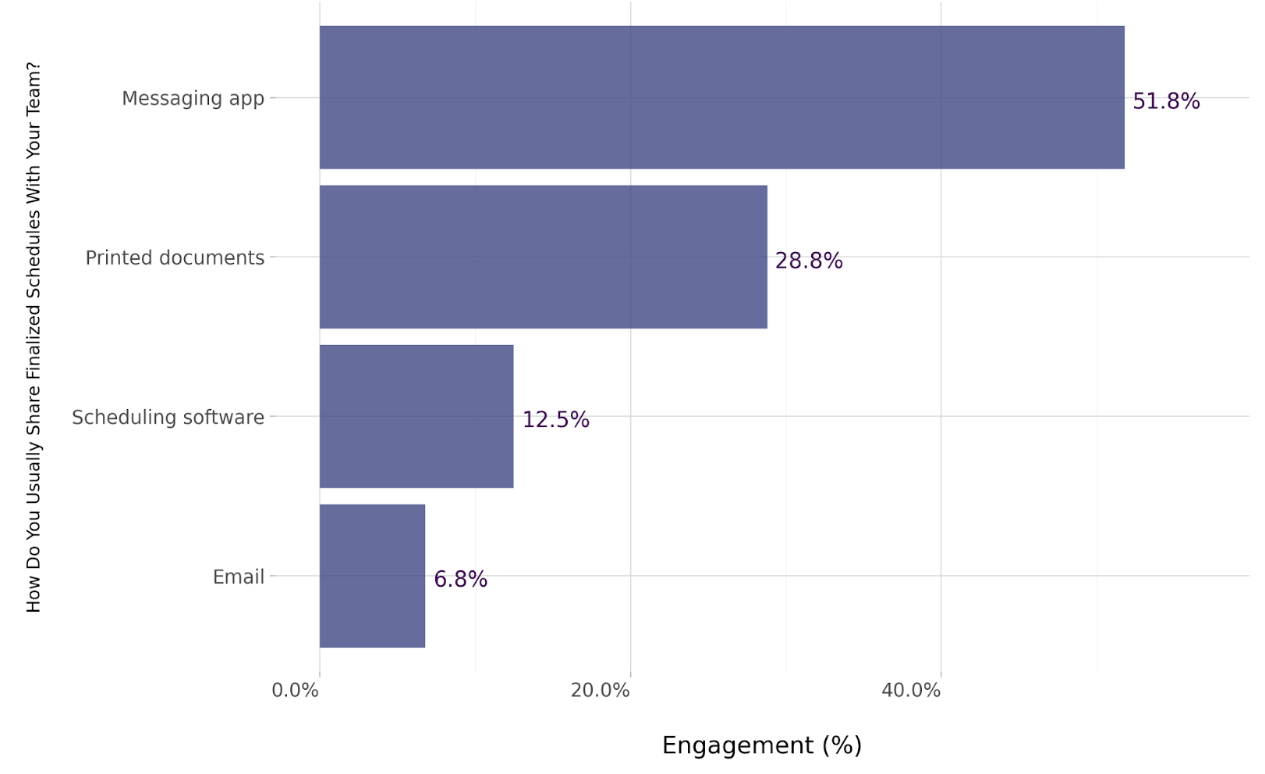
52% of our audience uses messaging apps to share the finalized schedules with their team. Considering Facebook Messenger has 200 million users in the US and WhatsApp boasts 98 million, these methods of communication are popular, quick, and easily accessible for all. Scheduling software is used by 13% and email by 7%, but here’s where the surprise comes in.
Despite the convenience, easy access, and widespread adoption of messaging, software, and email, a whopping 29% of filmmakers still use printed documents. This is likely because hard copies can be quickly referenced on set without relying on battery life, signal, or app navigation.
Which Type Of Project Do You Most Frequently Schedule?
Documentaries the most common project for 47% independent US filmmakers
For indie filmmakers, there are a few genres that stand out as the most popular to work on:
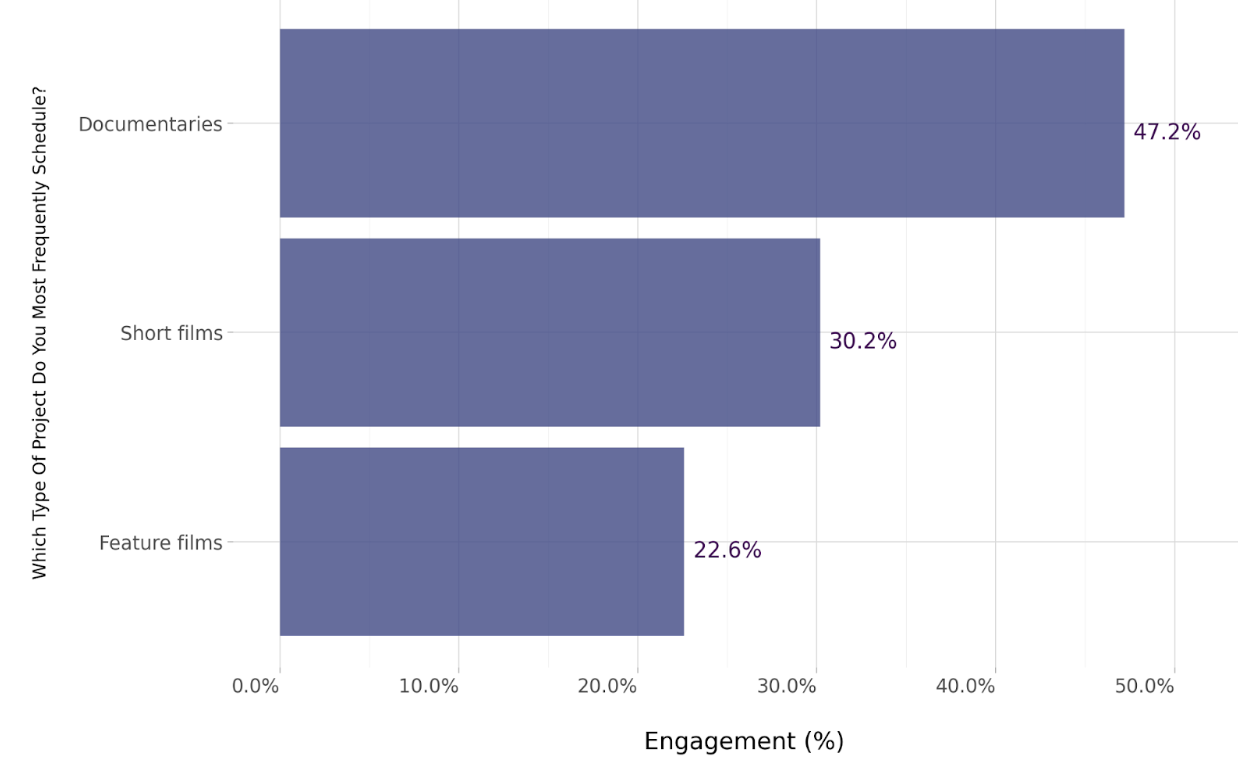
Documentaries lead the way, with 47% of filmmakers making them the most often. This is followed by short films for 30% feature films for 23%. Recent research shows that in 2023, independent documentaries reached 23.5 million US viewers, while scripted independent films reached 16.2 million. This points to a clear trend—documentaries are not only the most commonly produced format among independent filmmakers but also the most-watched.
Where In The USA is Your Film Production Primarily Based?
67% independent filmmakers in the US are based in the Midwest
Our audience of indie filmmakers is distributed across the US:
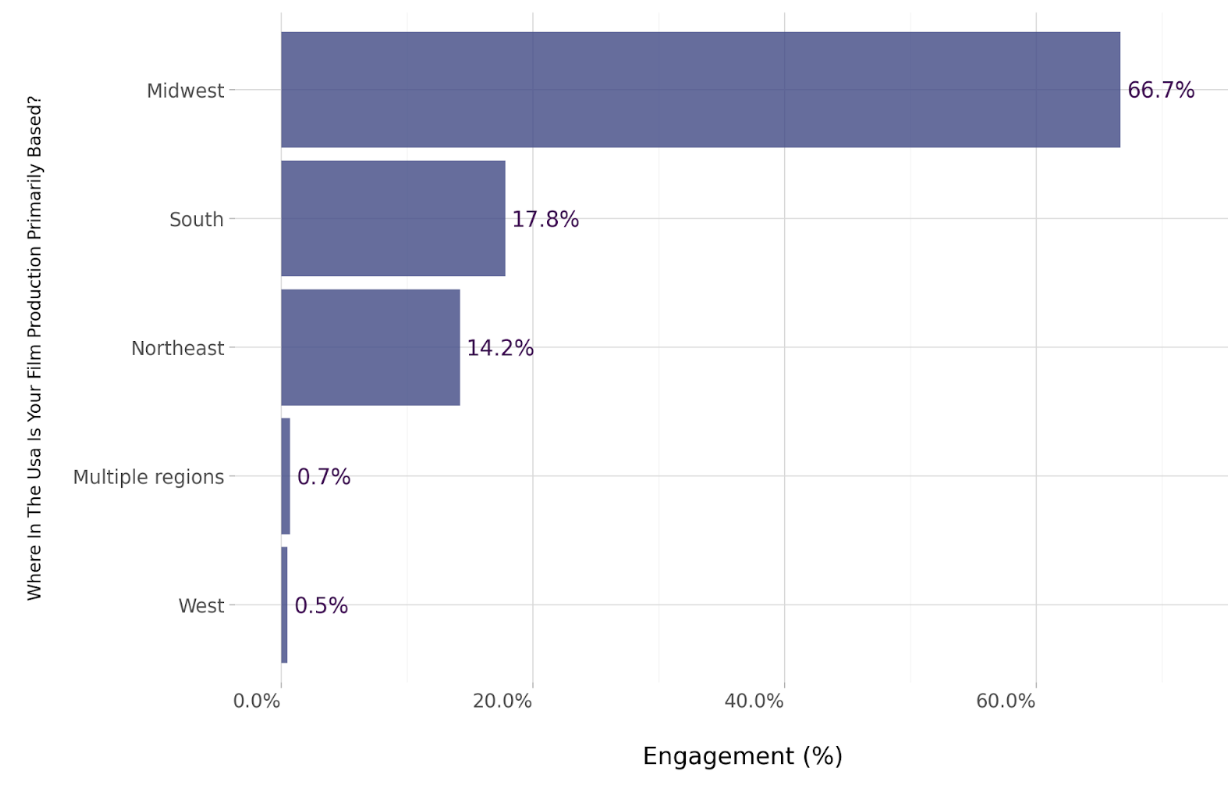
It’s clear that the Midwest dominates as the primary base for independent filmmakers in the US, with 67% located there. This high concentration may be driven by factors such as lower production costs, easier access to locations, fewer permitting restrictions, and strong community support for independent filmmaking. The South follows at 18%, likely benefiting from expanding film industries in cities like Atlanta and Austin and appealing tax incentives offered by states like Georgia and Louisiana.
The Northeast accounts for 14%, while only 1% of respondents reported working across multiple regions, likely due to the logistical and financial challenges of coordinating productions in different areas. Surprisingly, the West, including traditionally dominant hubs like Los Angeles, is only home to another 1% of filmmakers. However, this may be due to the high costs in these regions.
Overall, scheduling remains one of the most critical yet complex aspects of the independent filmmaking process. From the widespread reliance on assistants and the universal adoption of scheduling tools to the ongoing struggle with last-minute changes and maintaining shoot-day timelines, filmmakers continually navigate shifting circumstances, even with confidence in their planning.
Methodology
The data was sourced from an independent sample of 16,608 USA independent filmmakers from X, Quora, Reddit, TikTok, and Threads. Responses are collected within a 65% confidence interval and a 15% margin of error. Engagement estimates how many people in the location participate, and the demographics are determined using many features, including name, location, and self-disclosed description. Audience privacy is preserved using k-anonymity and differential privacy. Results are based on what people describe online. The questions were not posed to the people in the sample.
About the representative sample:
- 66% of independent filmmakers in the US are over the age of 45.
- 53% identify as female.
- 47% earn between $120,000 and $200,000 annually.
Best Film Screenwriting Software US in 2025
Find out what independent filmmakers want most in screenwriting software—from AI tools and cloud storage to collaboration features and bold design—and see how creative needs are shaping the future of writing platforms.
Best Film Production Software: USA 2025
Find out what filmmakers value most in their software tools, from editing support to progress tracking and post-production help, and learn why Pzaz is the ultimate creative partner in bringing your stories to life.


